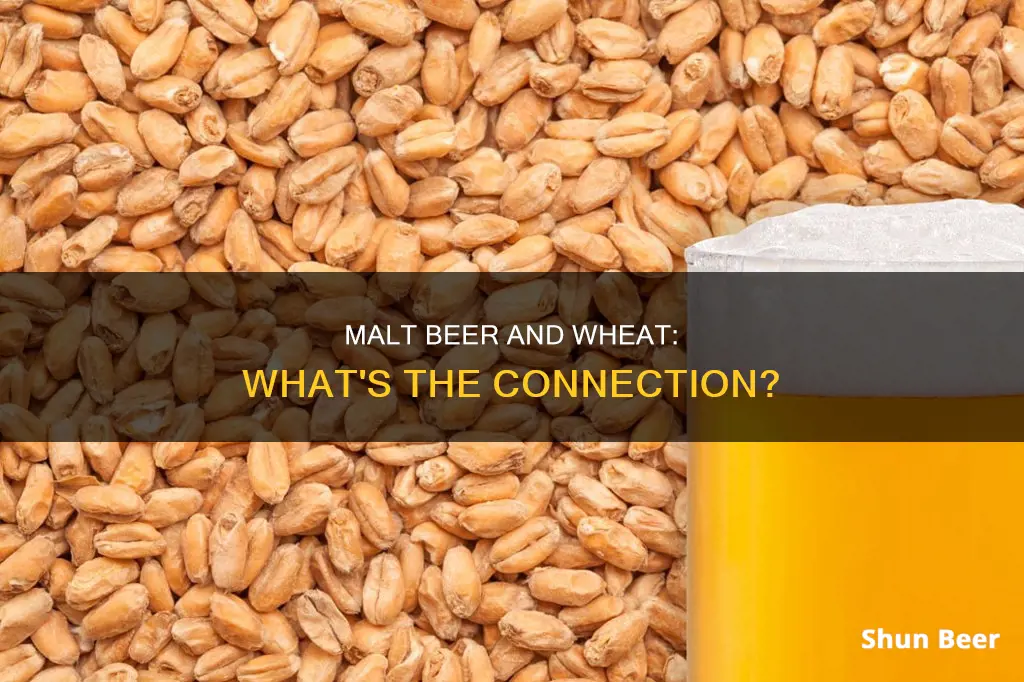
Wheat beers are typically brewed with malted wheat as the primary ingredient in the mash, rather than malted barley. Wheat beers are crisp and refreshing, with a lighter body than barley malt beers. They are often coupled with a touch of acidity, making them suitable for pairing with light dishes and seafood. Wheat beers are also known for their delicate texture and characteristic citrus notes.
| Characteristics | Values |
|---|---|
| Most common malted grain used in brewing | Barley malt |
| Second most common malted grain used in brewing | Wheat malt |
| Typical wheat-accented brews | German weissbier, German Berliner weisse, American wheat beer |
| German weissbier wheat malt content | At least 50% |
| German Berliner weisse wheat malt content | Up to 30% |
| American wheat beer wheat malt content | 10% to 35% |
| Wheat malt body | Lighter than barley malt |
| Wheat malt flavour | Gently refreshing touch of acidity |
| Wheat malt colour | Honey-orange |
| Wheat malt protein content | Higher than barley malt |
| Wheat malt husk | No husk |
What You'll Learn
- Wheat beer is brewed with malted wheat as the primary ingredient, but it usually also contains some malted barley
- Wheat malt imparts a lighter body than barley malt, often with a refreshing touch of acidity
- Wheat malt can be used to brew beers with a range of colours, from very pale to chocolate or black
- Wheat malt is higher in protein than barley malt, which can result in hazy beer
- Wheat malt is typically cheaper than barley malt and can add about 4 points to your extract yield

Wheat beer is brewed with malted wheat as the primary ingredient, but it usually also contains some malted barley
Wheat beer is primarily brewed with malted wheat, but it usually also contains some malted barley.
Wheat beer, which originated in Continental Europe, is a light and refreshing drink, perfect for a hot summer's day. It has a light colour and a hazy appearance, and its soft, crisp flavour works well with the addition of berries and other fruits.
Wheat is the second most common malted grain used in brewing, after barley malt. Wheat has a higher protein content than barley, which enhances its contribution to foam stability and gives a better, longer-lasting head on the beer. However, the higher protein levels can also create problems in the brewhouse and make the beer hazy.
Most wheat beers contain a mix of wheat and barley malts. Traditional Bavarian weissbiers ("white" beers) are brewed with up to 60-70% wheat malt, combined with 30-40% barley malt. In the US, craft breweries tend to use a lower proportion of malted wheat (40-50%), and in England, it is not uncommon to add a portion of up to 20% wheat malt to the grist to improve the beer's head retention.
While wheat malt is the primary ingredient in wheat beer, the absence of a husk in wheat grains can create lautering problems, so mashes rarely contain more than 70% wheat malt. Brewers can use a number of tricks to brew with 100% wheat malt, such as adding rice or oat hulls to the mash to aid filtration.
Witbier and Wheat Beer: What's the Difference?
You may want to see also

Wheat malt imparts a lighter body than barley malt, often with a refreshing touch of acidity
Wheat malt is the second most common malted grain used in brewing, after barley malt. Wheat malt imparts a lighter body than barley malt and is often coupled with a refreshing touch of acidity. This quality makes wheat-based beer styles suitable for pairing with light dishes and seafood, and they are also popular during hot weather.
Wheat malt is used in beers such as German weissbier (also known as hefeweizen or weizenbier), which must contain at least 50% wheat malt by law. German Berliner weisse is a sour, sparkling ale, whose wheat malt portion rarely exceeds 30%. Modern "American wheat beer" usually contains 10-35% malted wheat. Some American craft brewers have recently become fond of a barley wine variant called "wheat wine", replacing a large proportion of barley malt in the grist with wheat malt.
Wheat malt is also used in smaller quantities in beers to obtain a "bread" touch. It is typically added at 5% to most light beers to increase foam stability without affecting haze or flavour. The higher protein levels in wheat malt can create problems in the brewhouse and make the beer hazy, but it also contributes to foam stability and increases the beer's mouthfeel.
The physical and chemical differences between barley and wheat make malting wheat a challenging task. Wheat lacks the thick barley husk, absorbs water more quickly, and reaches modification more rapidly than barley. Kilning is done at lower temperatures than for barley, but the higher protein content assures a slightly darker colour, even in the palest wheat malt.
Hefeweizen: Wheat Beer, But Different
You may want to see also

Wheat malt can be used to brew beers with a range of colours, from very pale to chocolate or black
Wheat malt is the second most common malted grain used in brewing, after barley malt. Wheat malt can be used to brew beers with a range of colours, from very pale to chocolate or black.
The early weissbiers were known for their pale colour, and many craft brewers today offer wheat beers as their palest selection. In the US, American wheat beer is a pale and cloudy beer with little to no hop flavour or bitterness. Wheat malt will typically create a wort with a honey-orange colour, but different malting houses will have their own specifications, and dark wheat malts are now available.
For darker wheat beers, such as Dunkelweizen and Weizenbock, Munich malt or Vienna malt is used in place of the pale malt to help produce those darker colours and a slightly more malty flavour and reddish hue. Wheat malt can also be used in IPAs, Pale Ales, low-alcohol beers, bock beers, and session beers. Caracrystal® Wheat Malt, for example, adds subtle caramel and dark toast flavours to these styles.
Midnight Wheat Malt is another option that contributes the same colour characteristics as Black Malt but without the bitter, astringent, dry flavours or aftertaste. It is excellent in Black IPAs, Schwarzbiers, and other dark ales and lagers.
Wheat Beer Allergies: Understanding the Connection and Symptoms
You may want to see also

Wheat malt is higher in protein than barley malt, which can result in hazy beer
The presence of haze in beer is generally undesirable, as it can affect the clarity and appearance of the beer. However, some beer styles, such as wheat beers, are known for their hazy or cloudy appearance. Wheat beers often have a significant proportion of wheat malt in their grain bill, which can contribute to the hazy appearance of the final beer.
The protein content of wheat malt can also have other effects on the beer, such as increasing the foam stability and head retention. The proteins in wheat malt can also contribute to a fuller mouthfeel and enhance the beer's flavour.
The amount of haze in a beer can be controlled by various factors during the brewing process, such as the choice of malt, the mashing process, and the use of clarifying agents. By adjusting these factors, brewers can control the haze level in their beer to achieve the desired appearance and sensory characteristics.
In summary, wheat malt is higher in protein than barley malt, and this difference in protein content can contribute to haze formation in beer. Haze in beer can be desirable in certain styles, such as wheat beers, and brewers can use various techniques to control the haze level and create the desired beer characteristics.
IPAs and Wheat Beers: What's the Connection?
You may want to see also

Wheat malt is typically cheaper than barley malt and can add about 4 points to your extract yield
Wheat malt is the second most common malted grain used in brewing, after barley malt. Wheat-accented brews include German weissbier (also known as hefeweizen or weizenbier), which must contain at least 50% wheat malt by law, and the more modern American wheat beer, which usually contains 10-35% malted wheat.
Brewers often use wheat malt in conjunction with barley malt, as wheat lacks the thick barley husk that is crucial for mashing. Wheat also reaches modification more quickly than barley and has a higher protein content, which can create problems in the brewhouse and make the beer hazy. However, the higher protein content of wheat malt contributes to foam stability and increases the beer's mouthfeel.
Overall, wheat malt is a versatile and affordable option for brewers, offering a range of benefits that can enhance the flavour, appearance, and mouthfeel of the final beer.
Bass Beer and Wheat: What's the Connection?
You may want to see also
Frequently asked questions
Yes, malt beer can contain wheat. While barley is the most common malted grain used in brewing, wheat is the second most common. Wheat beers have become increasingly popular, and wheat is now used as the primary ingredient in the mash in many beers.
Malt is any cereal grain that has been made to germinate by soaking in water and then drying with hot air to stop further germination. This process is known as "malting". The malting process develops enzymes that are necessary for modifying the grains' starches into sugars.
Barley malt has a thick husk, while wheat malt has no husk. The husk is important in creating a filter bed for successful lautering. Wheat malt also has a higher protein content than barley malt, which can contribute to a fuller mouthfeel and enhanced head retention in beers.







